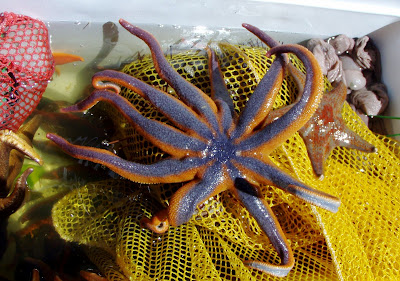
Sunset at Bamfield Marine Science Center
Note: Below are the field notes and pictures from Sarah Klain, a Masters student at the University of British Columbia who took part in some field research at Tofino and Bamfield this summer. While Sarah's story takes place away from the North Island, I thought that I would post anyway - I am sure there are North Islanders who can relate to her diving experiences. Thanks for sharing Sarah! Story and photos: credit Sarah Klain. Sea otters, a native species on the west coast of Vancouver Island, will likely re-colonize Barkley Sound in the next decade. I’m part of a UBC research team to study how kelp forest ecosystems will likely be transformed when otters, with their voracious appetites for urchins and shellfish, expand their range. Our study will also include how fisheries, recreation on the water and cultural values may change as sea otters become more abundant. Enticed by the adventure of diving in BC, I plunged into joining this team.

During the frenzy of field work, sleeping in meant rolling out of bed at 7:01 am, squeezing into four layers of long-underwear bottoms and five layers of fleece tops, downing rocket fuel coffee, scarfing cereal, and walk-skidding down the steep gravely hill to the Bamfield Marine Science Center dock by 7:29.

Fearless Leader Rebecca Martone
I slacked that morning relative to others on the dive team. The project leader Becca had been up for two hours preparing. Stefan, a fervent fishermen,had jigged for rockfish for his master’s research since before dawn and the never-complaining always-working field assistants Sarah and Jocelyn had already loaded half the tanks onto the dive boat. With quasi-bulging and too quickly tiring biceps, I lamely attempted to make up for my late arrival by carrying air tanks to the boat two at a time. After tanks, we loaded dive gear. Each of us had our personal pile of equipment necessary to dive and ward off hypothermia when immersed in the chilly waters of West Vancouver Island. Forgetting a single item-- hood, mask, BC, regulator, dry suit, dry gloves, booties, nearly 40 pounds of weights or fins --would forfeit the dive. Becca’s caffeinated brain checked items off as she counted and double-checked equipment, printed data sheets, lugged gear, and completed the myriad tasks necessary to get a team of five divers, including herself, into the water for kelp forest and rocky reef surveys.
 Equipment for Surveys
Equipment for SurveysThe muffled drone of the motor en route to the Barkley Sound study site provided needed respite from the bustle of preparing the boat. When we reached the dive site, it was constantly apparent that I had only recently completed my scientific dive course. Fumbling with everything, I had trouble dressing myself. I needed help zipping my dry suit. I pressed my self-inflate button on my drysuit only to realize I had forgotten to fasten the essential dry suit hose. I relied on others to fix my mask under my hood and help me pull on my tight dry gloves over the rigid plastic collars around my wrists. Feeling like a toddler, I swallowed any pride in trying to be self-sufficient and relied on the team to make sure I would be able to breathe underwater and stay mostly dry (water trickled down my neck when looking around too eagerly). With our broad shouldered black drysuits, we were a team of undersea ninjas. Laden with the gear that engulfed our bodies, we resembled futuristic astronaut superheroes, perhaps sketched in a comic book predating space travel.

Superhero Dive Ninjas?
My awkwardness was relieved when I descended at the edge of my known universe since this was my first dive in a kelp forest full of species I had only recently studied in books. Drifting downwards while hearing only the sound of my bubbly breath relieved the weight of self-consciousness about my morning tardiness, newness to scientific diving, worries about forgetting gear and anxiety over learning over 40 species too slowly. While underwater, my tension mostly dissolved as I recorded and measured species while reveling in the colorful riot of life that surrounded and at times entangled me. Bull kelp and giant kelp wrapped around my legs, arms, and hoses while I swam through the undersea forests. Just like a Chinese finger trap, the more I struggled, the more ensnared I became. Sometimes I resorted to cutting myself free with the dive knife that contributed to the superhero look. Usually extraction only required calmness as the surge often gently disentangled the fronds if I stopped fighting the kelp and focused on my survey.

Red Urchin
Our surveys of kelp forests and rocky reefs will answer questions about the cast of undersea characters (biodiversity) and the roles they play (food web structure). The lead characters in the motley crew of Barkley Sound include kelp and spiny red urchins that actually range in color from deep purples to pink. Sculpins, fish that resemble curmudgeony old men, made eyes at us. Striped and textured sea stars, kelp, algae, elegantly feathered and multi-colored sea slugs called nudibranchs, crabs, abalone, rockfish and more filled thequadrats (squares) and transects (lines) that we surveyed. Our research involved identifying, counting and measuring plants as well as animals, particularly commercially harvested species, to compare sites with and without sea otters.

Sea star collection cooler
After completing the dive surveys, I progressed from feeling like a toddler to a young child. I could understand the foreign sounding Latin names of species and stutter a handful of them myself. I advanced from my what-have-I-forgotten fretting over personal gear to helping with group equipment. Perhaps, after a few thousand more dive surveys, I’ll advance to superhero scientific diver status.
 Collecting specimens from kelp forests
Collecting specimens from kelp forests This integrative project, spearheaded by Kai Chan and Russell Markel, involves several investigators including Chris Harley, Jon Shurin, Evgeny Pakhomov, Rebecca Martone and Anne Salomon.
 Vermilion sea star
Vermilion sea star











